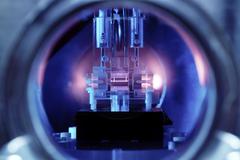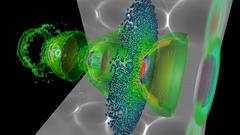Student Portal
This is a site for students by students and other researchers working on novel accelerators.
It is your site where you can find useful information such as resources for professional development (books, articles, schools), awards, links to groups and research opportunities in the area of novel accelerators (see the Student Portal drop down menu on the right hand side at the top of this page). If you have anything you find useful and you would like to share it with others on this portal, please contact moderators listed on the right hand side of this page.
Plasma source for wake experiements, (court. J. Osterhoff)
A dense gas, enclosed in a cell, just a few millimeters wide marks the key point of a plasma wake accelerator.
The cell is located inside the vaccuum chamber of a electron beam that will act as driver to ignite the plasma process and provide acceleration gradients of many GeV/m.
A plasma wake simulation, (court. R. A. Fonseca)
using CPU intensive computer programs, the process of plasma creation, the capture of an injected electron bunch and the actual acceleration process can be studied.
The 3d simulation codes thus ca be used to understand and optimise the plasma parameters in order to reach highest acceleration gradients and beam quality of the accelerated electron bunches.
Plasma wake creation, (court. AWAKE experiment, CERN)
using a "long" bunch of protons. Even if the dimensions of the proton bunch are much larger than the typical plasma wavelength, wake fields can be produced due to the so-called micro bunching effect. In each of these micro bunches, electrons - injected from a external source - can be accelerated with high gradients.



